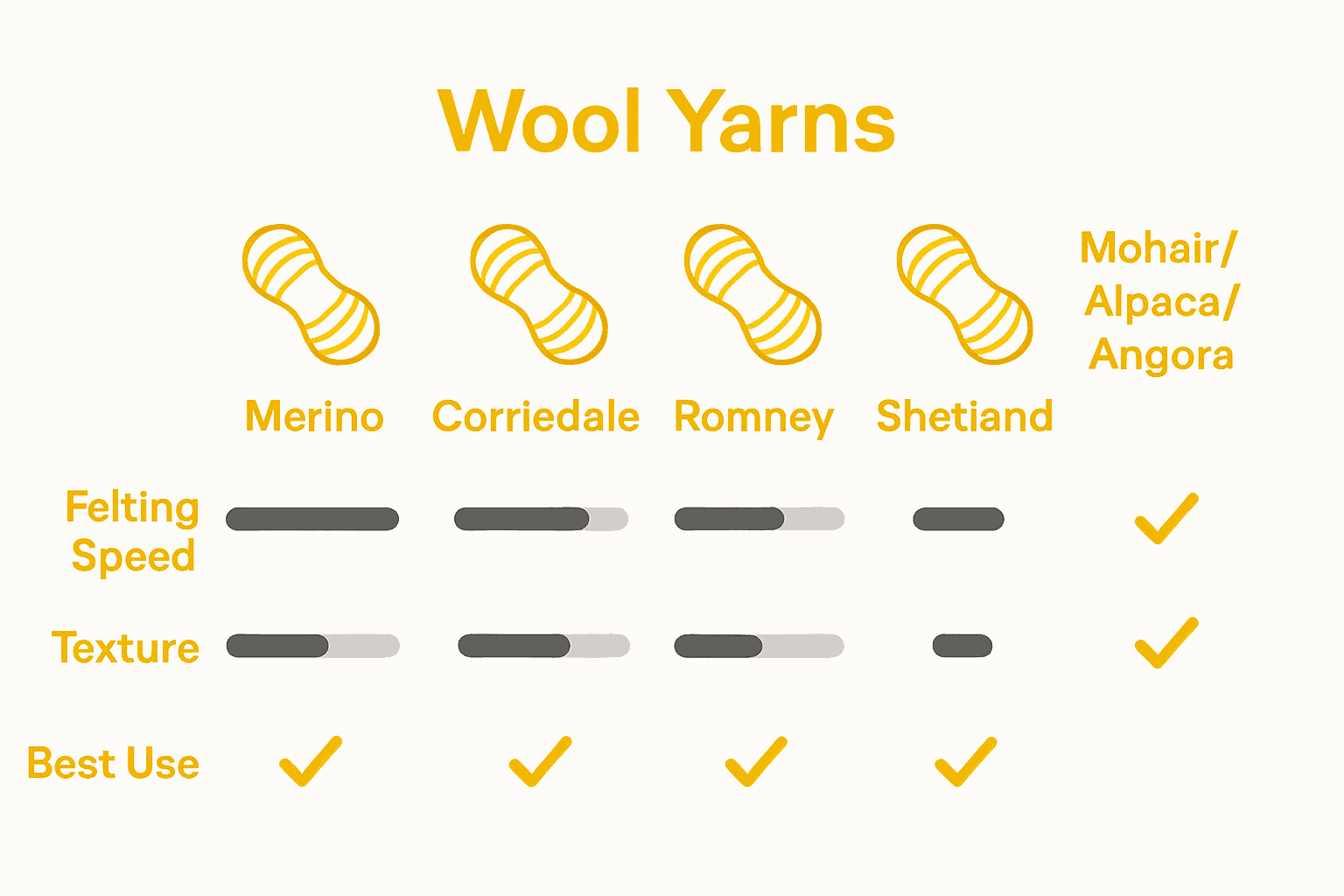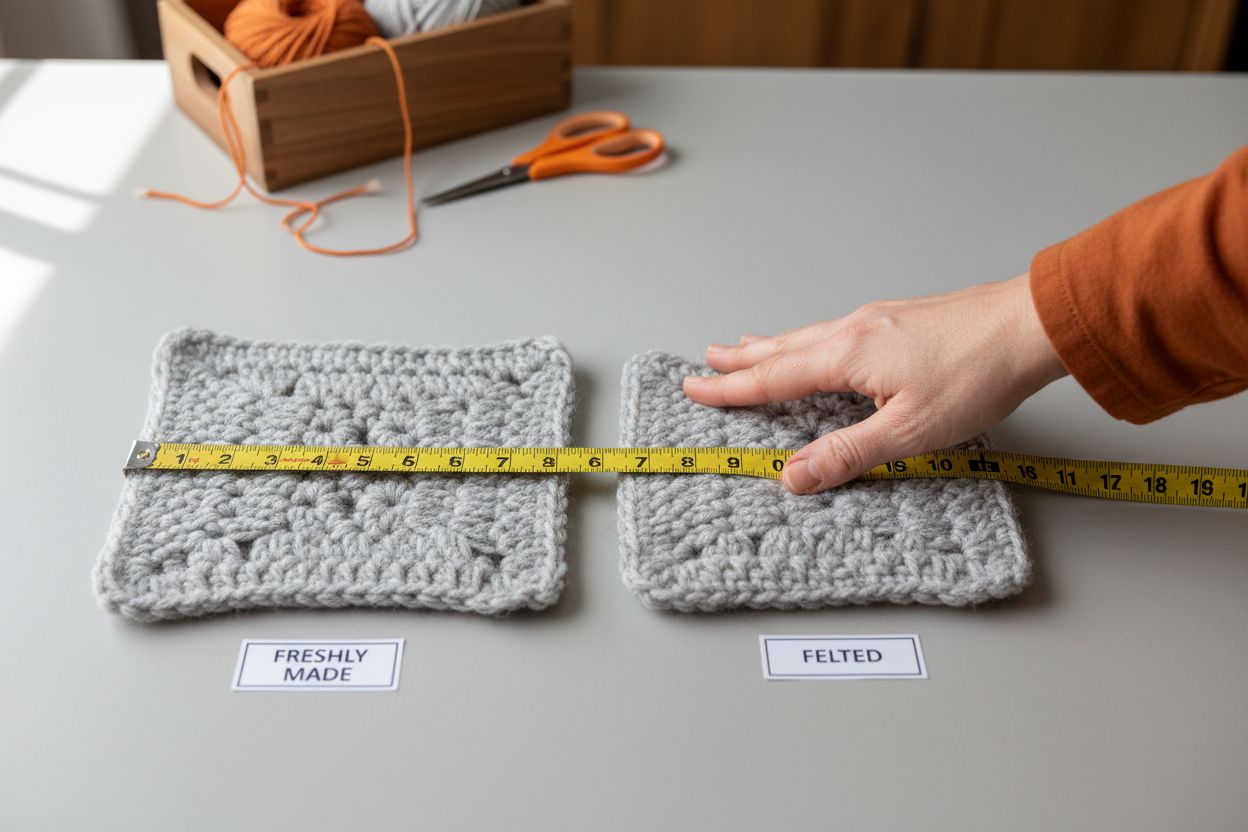
Complete Guide to Felting in Crochet Techniques
Did you know that wool can shrink up to 30 percent when felted, creating thick, durable fabric from ordinary crochet? Felting in crochet combines science and creativity, letting makers transform soft fibers into sturdy works of art. Mastering this technique opens up endless possibilities for functional and decorative pieces, as each project becomes uniquely shaped by the heat, moisture, and movement applied during felting.
Key Takeaways
| Point | Details |
|---|---|
| Understanding Felting | Felting involves shrinking and matting 100% wool fibers through moisture, heat, and agitation to create compact, durable pieces. |
| Choosing the Right Yarn | Using suitable yarns like Merino, Corriedale, and Romney is essential for optimal felting results; avoid blends and synthetic fibers. |
| Key Process Elements | Successful felting requires careful management of temperature, moisture, and agitation to transform crocheted pieces into felted art. |
| Common Pitfalls | Ensure projects are oversized to account for shrinkage, and avoid miscalculating yarn types and dimensions to prevent felting failures. |
Table of Contents
- Felting In Crochet Defined And Explained
- Types Of Yarns Suitable For Felting
- How The Crochet Felting Process Works
- Best Uses And Creative Applications
- Risks, Common Mistakes, And Pitfalls
Felting in Crochet Defined and Explained
Crochet felting transforms ordinary wool projects into dense, compact masterpieces through a magical process of intentional fiber manipulation. According to Annie’s Attic, felting is specifically the process of shrinking and matting 100 percent wool fibers by strategically applying moisture, heat, and agitation.
The science behind felting is fascinating. Wool fibers have microscopic scales that, when exposed to hot water and movement, interlock and tangle, creating a remarkably strong and compact fabric. As Interweave research explains, this technique is most effective when the wool is wet, helping crafters create incredibly durable items like bags, accessories, and decorative pieces.
Key characteristics of successful felting include:
- Using 100% pure, untreated wool
- Applying consistent hot water temperature
- Generating significant fiber agitation
- Avoiding synthetic or washable wool blends
Practically speaking, felting works best with specific wool types that have prominent fiber scales. Not all wool is created equal. Some wool varieties felt more effectively, producing tighter, more uniform results. Your choice of initial yarn and project design will dramatically impact the final felted texture and appearance.
Types of Yarns Suitable for Felting
Not all yarns are created equal when it comes to felting. According to Wool Buddy, certain wool types excel in the felting process, offering unique characteristics that transform your crochet projects.
Wool Varieties for Felting
Merino Wool stands out as a premier choice, known for its fine, soft texture that creates smooth, refined felted surfaces. However, it offers less structural integrity compared to other wool types. Wikipedia’s research confirms that animal fibers with prominent scales work best for felting, making Merino an excellent starting point.
Other outstanding wool varieties include:
- Corriedale: Medium-coarse wool with excellent strength and structure
- Romney: Medium-coarse with high crimp, perfect for quick felting in bags and hats
- Shetland: Coarser wool that felts rapidly, ideal for rustic, textured pieces
Key factors to consider when selecting felting yarn include fiber scale prominence, wool coarseness, and intended project complexity. Animal fibers like alpaca, mohair, and angora also work wonderfully, as their natural scales allow for remarkable fiber entanglement during the felting process.
 Choose your yarn wisely, and watch your crochet project transform into a dense, durable masterpiece.
Choose your yarn wisely, and watch your crochet project transform into a dense, durable masterpiece.
Here’s a comparison of popular wool types for felting crochet projects:
| Wool Type | Texture | Felting Speed | Best Uses |
|---|---|---|---|
| Merino | Fine, soft | Moderate | Smooth surfaces Accessories |
| Corriedale | Medium-coarse | Fast | Structured pieces Bags |
| Romney | Medium-coarse, high crimp |
Very fast | Bags Hats |
| Shetland | Coarse | Very fast | Rustic items Wall hangings |
| Mohair/Alpaca/Angora | Soft, silky | Moderate to fast | Artistic designs Blends |
How the Crochet Felting Process Works
The crochet felting process is a fascinating transformation that turns loose, airy wool projects into compact, sturdy pieces. Interweave explains that the technique involves deliberately crocheting with a loose gauge using pure wool, then intentionally subjecting the piece to hot water and strategic agitation.
The Science of Fiber Transformation
When wool fibers are exposed to heat and movement, something magical happens. The tiny scales on each fiber begin to open up and interlock, creating a dense, more dimensional fabric. According to Wikipedia’s research on wet felting, this process can be accelerated by using specific techniques like:
- Wrapping the wool in textured materials like burlap
- Applying consistent friction
- Maintaining high water temperature
- Compressing the fibers through rolling or fulling
The key stages of felting involve three critical elements: temperature, moisture, and agitation. As you manipulate your crocheted piece, the wool fibers gradually tighten, shrink, and merge into a more cohesive structure. The result? A transformed piece that’s stronger, more compact, and often significantly smaller than your original crochet project.
 Each felting session is unique, making every project an exciting textile adventure.
Each felting session is unique, making every project an exciting textile adventure.
Best Uses and Creative Applications
Felted crochet transforms ordinary projects into extraordinary, durable creations with remarkable versatility. Interweave highlights that felting is particularly exceptional for items requiring structural integrity, especially bags and totes where precise sizing becomes less critical.
Practical and Artistic Applications
The creative potential of felted crochet extends far beyond simple accessories. Crafters can leverage this technique to produce:
- Sturdy handbags and totes
- Decorative home accessories
- Structured winter accessories like hats and mittens
- Artistic wall hangings
- Unique textile sculptures
While traditional felting focuses on wool, innovative techniques like Nuno felting demonstrate the expanding boundaries of textile art. This technique beautifully bonds wool fibers onto lightweight fabrics like silk, creating intricate layered designs that merge different textures and weights.
The magic of felted crochet lies in its ability to transform soft, seemingly fragile yarn into robust, sculptural pieces. Each project becomes a testament to the incredible malleability of wool fibers, offering crafters an opportunity to experiment with form, function, and artistic expression. Whether you’re creating practical items or pure art pieces, felted crochet provides a unique canvas for creativity.
Risks, Common Mistakes, and Pitfalls
Felting might seem straightforward, but numerous pitfalls can derail your creative process. Annie’s Attic warns that gauge and sizing are critical considerations, emphasizing that your unfelted project must be intentionally oversized to accommodate predictable shrinkage during the felting process.
Yarn Selection Challenges
The most fundamental risk in felting revolves around yarn selection. Interweave highlights a critical mistake many crafters make: using inappropriate yarn types. Potential risks include:
- Choosing wool blends that resist felting
- Using ‘superwash’ treated yarns
- Selecting synthetic fiber compositions
- Miscalculating initial project dimensions
Successful felting demands precise material selection and technique. Untreated, 100 percent wool remains the gold standard, offering predictable shrinkage and optimal fiber interlocking. Crafters must approach felting with patience, understanding that each project presents unique challenges. Experimental techniques, careful gauge measurement, and a willingness to learn from initial attempts will transform potential pitfalls into opportunities for textile mastery.
Elevate Your Crochet Felting Projects with the Right Yarn
Have you ever felt frustrated when your crochet felting project did not turn out as strong or beautiful as you hoped? The Complete Guide to Felting in Crochet Techniques explains that choosing the wrong yarn or fiber can make your felted pieces look flat or fail to felt at all. Using 100 percent pure wool is critical for fiber interlocking and durability, and not all yarn is created equal. Discovering which yarn creates the stable, dense texture you want can be confusing and time-consuming.
.png)
Transform your felting results by starting with trusted, premium materials. CRAFTISS curates a collection of felting-friendly Yarn made especially for crochet artists like you. Whether you want smooth merino or structured blends, you will find exactly what your project demands. Explore even more inspiration and solutions for your creative journey by visiting CRAFTISS. If you are tired of disappointing felting experiments, shop now and start creating sturdy, beautiful projects today.
Frequently Asked Questions
What is the process of felting in crochet?
Felting in crochet involves crocheting with pure wool, then intentionally exposing the finished piece to hot water, moisture, and agitation. This transforms the loose fibers into a dense, compact fabric through the interlocking of microscopic scales on the wool.
What types of yarn are best for felting in crochet?
The best yarns for felting are 100% untreated wool varieties. Merino, Corriedale, Romney, and Shetland wool are excellent choices, as they possess prominent fiber scales that facilitate effective felting.
Why is it important to use untreated wool for felting?
Untreated wool is crucial for successful felting because it allows the microscopic scales on the fibers to interlock and tangle during the felting process. Using synthetic or treated wool can hinder this process, resulting in ineffective or inferior felted results.
What are common mistakes to avoid when felting crochet projects?
Common mistakes include using the wrong type of yarn (like blends or superwash treated wool), miscalculating project dimensions, and failing to account for the needle gauge. Ensuring proper yarn selection and adjusting your dimensions to accommodate shrinkage are essential for successful felting.


